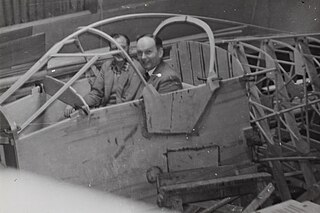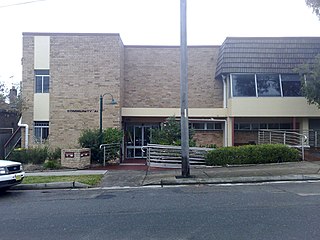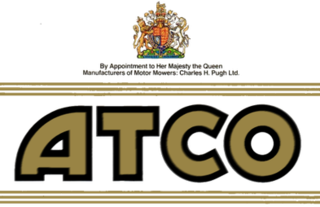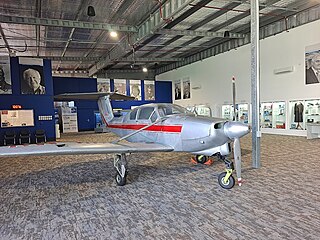
A lawn mower is a device utilizing one or more revolving blades to cut a grass surface to an even height. The height of the cut grass may be fixed by the design of the mower but generally is adjustable by the operator, typically by a single master lever or by a mechanism on each of the machine's wheels. The blades may be powered by manual force, with wheels mechanically connected to the cutting blades so that the blades spin when the mower is pushed forward, or the machine may have a battery-powered or plug-in electric motor. The most common self-contained power source for lawn mowers is a small 4-stroke internal combustion engine. Smaller mowers often lack any form of self-propulsion, requiring human power to move over a surface; "walk-behind" mowers are self-propelled, requiring a human only to walk behind and guide them. Larger lawn mowers are usually either self-propelled "walk-behind" types or, more often, are "ride-on" mowers that the operator can sit on and control. A robotic lawn mower is designed to operate either entirely on its own or less commonly by an operator on a remote control.

Briggs & Stratton Corporation is an American manufacturer of gasoline engines with headquarters in Wauwatosa, Wisconsin.

The Pacific Aerospace Corporation CT/4 Airtrainer series is an all-metal-construction, single-engine, two-place with side-by-side seating, fully aerobatic, piston-engined, basic training aircraft manufactured in Hamilton, New Zealand.

Outboard Marine Corporation (OMC) was a maker of Evinrude, Johnson and Gale Outboard Motors, and many different brands of boats. It was a multibillion-dollar Fortune 500 corporation. Evinrude began in Milwaukee, Wisconsin in 1907. OMC was based in Waukegan, Illinois. They also owned several lines of boats such as Chris Craft, Lowe Boats, Princecraft, Four Winns, SeaSwirl, Stratos, and Javelin. OMC was also a parent company to Lawn-Boy and Ryan, which made lawn mowers.

Lawnmower racing is a form of motorsport in which competitors race modified lawnmowers, usually of the ride-on or self-propelled variety. The original mower engines are retained, but blades are removed for safety. The sport attracts all ages, and is usually entered into in a spirit of fun rather than extreme competitiveness, though many participants do take it seriously.

Murray was an American company whose assets are now owned by Briggs & Stratton and Pon Holdings. The corporate brand is a descendant of the Murray Ohio Manufacturing Company, which manufactured bicycles and lawn and garden equipment. The company went bankrupt in 2005 selling most of its assets to Briggs & Stratton and Pacific Cycle.

Henry K. Millicer, AM born Henryk Kazimierz Milicer, was a Polish-Australian aircraft designer and pilot.

Ariens Company, stylized as AriensCo, is an American equipment company based in Wisconsin which has a long history manufacturing snow blowers, lawn tractors, and zero-turn lawn mowers for commercial and high-end consumer markets. Ariens touts itself as being the "mower of the White House lawn," "official snow blower of Lambeau Field," and the "King of Snow".

MTD Products is an American manufacturer of outdoor power equipment for the mass market. Headquartered in Valley City, Ohio, the company began in 1932 and is a wholly-owned subsidiary of Stanley Black & Decker. Prior to Stanley Black & Decker's acquisition in December 2021, MTD Products was a majority family-owned, private company. It originated as a tool and die maker. MTD's main competitors are Stihl, Ariens, Briggs & Stratton, John Deere and Husqvarna.
Lawn-Boy is a brand of lawn mower, originally manufactured by the Evinrude Company in 1934 and owned since 1989 by Toro. It was the first one-handed reel power mower introduced to the American public. Evinrude purchased Johnson Motor Wheel Company from a New York stock brokerage firm a year later, and in 1936 they merged with the Outboard Marine and Manufacturing Company (OMC), continuing production of Lawn-Boy mowers until 1939, when it was temporarily put on hold to manufacture outboard motors for World War II.

Flymo is a hover lawnmower invented by Karl Dahlman in 1964, after seeing Sir Christopher Cockerell's hovercraft. "Flymo" is a brand name of the Swedish company Husqvarna AB, a part of Electrolux from 1978 to 2006. The mower is a variation of the petrol-powered rotary push lawn mower, but uses a fan above the mower's spinning blades to allow the mower's body to hover over the lawn. The mower is claimed to be more manoeuvrable and easier to push than wheeled petrol mowers, while delivering similar results.

The Victa Airtourer is an all-metal light low-wing monoplane touring aircraft that was developed in Australia, and was manufactured in both Australia and New Zealand.
Mervyn Victor Richardson, was an Australian inventor and industrialist. In 1952 he produced a rotary lawn mower that proved popular leading to the formation of the company Victa. He commercialised the mower with creation of Victa Consolidated Industries and later went on to extend the business to include the manufacture of the Victa Airtourer and Victa Aircruiser aircraft and project homes.
Snapper, Inc. was an American company, formerly based in McDonough, Georgia, that manufactured residential and professional lawn-care and snow-removal equipment. Snapper was known for their high-quality products, including rear-engine riding lawnmowers capable of standing on end for storage or repair, and for their invention of the first self-propelled rotary lawn mower.

A rotary mower is a unit of powered machinery that uses a rotating blade or blades to cut vegetation.
The Victa Aircruiser was a 1960s Australian four-seat touring monoplane designed by Henry Millicer and built by Victa. It was not put into production by Victa, and the rights were sold to AESL in 1969.

The City of Canada Bay Museum is located in Sydney, Australia, in the suburb of Concord.

Atco (Atlas Chain Company) Limited was a British mower company which traded as "Atco Ltd" from 1981 to 1990, making lawn mowers and garden tools. It sold a range of lawn mowers including lawn and garden tractors.
The Brumby Aircruiser is a four-seat general aviation aircraft currently under development by Brumby Aircraft Australia. The design has its origins in the 1960s Victa Aircruiser, itself a development of the successful Victa Airtourer.

The Victa R-2 was a prototype Australian single-engine four-seat light aircraft built by Victa Ltd in the early 1960s. A single example was built, first flying in February 1961, but no production followed.

















